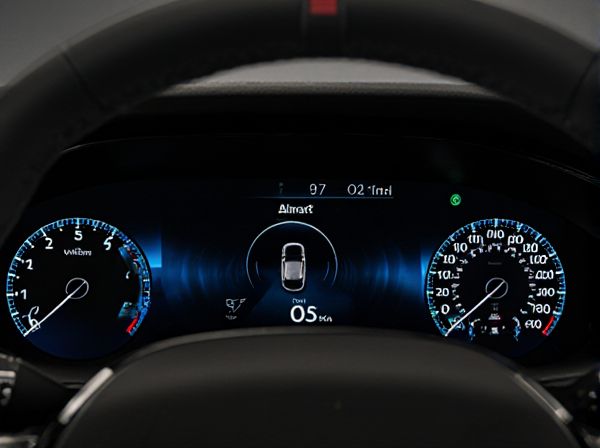
Photo illustration: Virtual Cockpit vs Physical Dial
A Virtual Cockpit offers customizable digital displays that provide real-time information and enhanced navigation features, making your driving experience more intuitive and interactive. Physical dials, on the other hand, offer tactile feedback and traditional gauge reading, which some drivers find more reliable and easier to interpret at a glance. Choosing between the two depends on your preference for modern technology or classic, straightforward instrumentation.
Table of Comparison
| Feature | Virtual Cockpit | Physical Dial |
|---|---|---|
| Display Type | Digital LCD screen | Analog mechanical dials |
| Customization | Fully customizable layout | Fixed layout with limited changes |
| Information Display | Multi-function: speed, navigation, media, alerts | Basic: speedometer, tachometer, fuel gauge |
| Visibility | Adaptive brightness, high contrast | Standard backlighting, manual adjustment |
| Response Time | Instant digital updates | Mechanical movement delay |
| Durability | Solid-state, less prone to wear | Prone to mechanical wear over time |
| Cost | Higher due to advanced tech | Lower manufacturing cost |
Introduction: Understanding Virtual Cockpit and Physical Dial
Virtual Cockpit integrates digital displays and customizable interfaces to replace traditional analog gauges, providing dynamic information tailored to driving conditions. Physical dials rely on mechanical or electromechanical components to present fixed, real-time data through tactile, easy-to-read gauges. Understanding the key differences highlights how Virtual Cockpit enhances user experience with software-driven flexibility, while Physical Dials offer reliability and simplicity in vehicle instrumentation.
Evolution of Car Dashboard Interfaces
The evolution of car dashboard interfaces has shifted from traditional physical dials to advanced virtual cockpits, integrating digital displays with customizable information layouts. Virtual cockpits provide enhanced driver interaction through high-resolution screens that consolidate speed, navigation, and vehicle diagnostics into a single interface. This transformation improves safety and user experience by reducing distraction and allowing seamless updates via software enhancements.
Design and Aesthetics Comparison
The Virtual Cockpit offers a sleek, customizable digital interface that integrates seamlessly with modern vehicle interiors, enhancing design fluidity with high-resolution displays and dynamic graphics. Physical dials provide tactile feedback and a classic, mechanical aesthetic favored for its simplicity and reliability, often appealing to traditional automotive enthusiasts. While virtual cockpits emphasize innovation and adaptability in design, physical dials prioritize straightforward functionality and nostalgic visual appeal.
User Experience: Virtual Cockpit vs Physical Dial
Virtual Cockpit offers a dynamic user experience with customizable digital displays that adapt to driving conditions and preferences, enhancing visibility and information accessibility. Physical dials provide tactile feedback and intuitive control, benefiting users who prefer straightforward interaction without screen distractions. In terms of usability, Virtual Cockpit excels in flexibility and integration with advanced features, while Physical Dials maintain reliability and ease of use under all driving scenarios.
Functionality and Customization Features
The Virtual Cockpit offers advanced functionality with a fully digital interface that allows seamless integration of navigation, media, and vehicle data on customizable displays. Physical dials provide tactile feedback and straightforward control, often preferred for precise adjustments and minimal distraction. Virtual Cockpit's customization features enable users to tailor layouts, switch between different display modes, and update software for new functionalities, surpassing the static nature of traditional physical dials.
Safety and Driver Focus Implications
Virtual Cockpits enhance safety by providing customizable, real-time data displays that reduce distraction through intuitive interfaces and adaptive brightness. Physical dials, while traditionally reliable, may require more visual refocusing, potentially diverting driver attention from the road. The integration of virtual systems supports driver focus by consolidating critical information within the line of sight, minimizing cognitive load and reaction time.
Reliability and Maintenance Considerations
Virtual Cockpits offer enhanced reliability by minimizing mechanical failures common in Physical Dials, as they rely on digital displays with fewer moving parts. Maintenance for Virtual Cockpits often involves software updates and diagnostics, which can be performed remotely, reducing downtime compared to the manual calibration and part replacement required for Physical Dials. Although Physical Dials provide tactile feedback, their susceptibility to wear and environmental damage makes Virtual Cockpits a more durable and low-maintenance option in modern vehicle design.
Cost and Value Analysis
Virtual cockpits reduce manufacturing and maintenance costs by replacing multiple physical dials with customizable digital displays, lowering material and assembly expenses. Physical dials, while often more intuitive and durable in harsh environments, incur higher costs due to mechanical components and require more complex repairs. The value of virtual cockpits lies in their flexibility, software updates, and integration capabilities, offering enhanced user experience and long-term cost efficiency compared to traditional physical dial systems.
Consumer Preferences and Market Trends
Consumer preferences are increasingly favoring virtual cockpits for their customizable displays and integration with advanced infotainment systems, driving automakers to invest heavily in digital instrument clusters. Market trends reveal a significant shift towards touch-based interfaces and augmented reality features that enhance user interaction and safety, while physical dials remain valued in luxury and performance vehicles for tactile feedback and reliability. Data from automotive industry reports highlight a projected annual growth rate of over 12% in virtual cockpit adoption, reflecting evolving consumer demand for innovative in-car technology.
Future Outlook: What’s Next for Car Cockpits?
The future of car cockpits is rapidly shifting towards enhanced Virtual Cockpit systems that integrate high-resolution digital displays with customizable interfaces, offering drivers real-time data through augmented reality and AI-driven insights. Physical dials are increasingly being supplemented or replaced by touch-sensitive controls and voice commands that prioritize safety and user experience. Advancements in connectivity and autonomous driving technologies will further transform cockpits into fully interactive and adaptive environments tailored to individual preferences and driving conditions.
 caratoz.com
caratoz.com